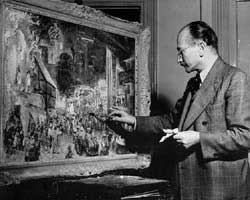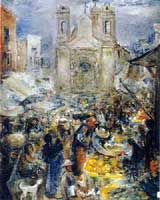
|
P U B L I C A T I O N S > R E M I N I S C E N C E S
Ary Comes Back To The United States (1933-1941) When Ary returned from Europe in 1933 he found
that the money he had left behind for a friend to handle had
been badly invested and there was nothing left of it. Ary was
penniless and these were the days of the depression.
I don't have a very clear picture of Ary in these
days, for this was the period about which he talked the least.
It must have been a sort of nightmare for him. Several friends
bought paintings, and this helped him out, and he was taken
up by the Midtown
Gallery for a one-man show, which helped him get a footing
in the New York art world. But when all the guests had left
after the preview at Midtown he walked over to Central Park
and sat there for hours, lost in melancholy. He missed his beloved
Paris, and he didn't seem to fit into the art scene here, which
was pretty much dominated by Americana — the Grant Wood,
Thomas Benton style. Despite all this, Ary managed to get on the WPA Project, although late in being accepted because he found out about it quite by accident, the "gang" not having advised him what was happening. He wasn't on the Project more than a couple of years, I believe, because when the order went out that only those who had no money at all and were on relief would be retained, Ary, who had finally salvaged a small sum from his real estate holdings in Europe, and had put it away as an emergency fund, would not represent himself as penniless. He did have several years on the Project, however, and was very conscientious about handing in good canvases. What happened to them I don't know, except that Colonel David Orr (I haven't been able to locate Col. Orr.) of Cedarhurst, Long Island, has one — "New York Night Scene — El Station." A school in Queens had another — "Little Harbor" — but when I inquired of the principal recently he didn't know what had happened to it. The American Archives of Art in Detroit sent the Foundation photographs of these two paintings, and three more: "Saturday at Coney," "Over the Roofs" and "Excavation". There was no record of what had been done with the paintings, other than the first two.
As one can see by the above
titles, Ary had found the streets and crowds of New York rich
in material for compositions, and he found great excitement
in the life and movement of the city. Ary himself, when we were
in Mexico in the 60s, dictated the chapter on "Movement"
which is contained in this series of reminiscences. I didn't
know him during the years he was painting Broadway, Coney Island,
Madison Square Garden, the World's Fair. But I could sense a
resurgence of that excitement when he would tell me about those
days — evening after evening watching and feeling the movement
of the crowds on 42nd Street and fascinated by the play of light;
night after night in the glitter and rhythm and abandon of Coney
Island at its heyday. Caught up in the thrill of the Coney Island
scene, he even rented for a month a room in the honky-tonk district,
so that he could be in the very midst of it all and absorb the
atmosphere to the utmost and transform the loudness and brassiness
and vulgarity of it to a self-created world of glamour.
In December 1940 Ary
stored his paintings and a few pieces of furniture with friends
and set out for Mexico. He spent six months there, living at
an old Mexican hotel (now torn down), which over-looked the
Zocalo, and traveling by bus throughout the country. That is
when he met Nick Curcio, a lawyer from the United States who
had gone to Mexico on a holiday several years before and had
remained to make his home there. Nick, with his Latin temperament
(he was of Italian descent) was a gay and stimulating friend
and he and Ary spent many hours together, roaming about the
city or sitting on the little balcony in front of Ary's hotel
room, looking down at the Zocalo. Many paintings remain from
that period. The family and the Foundation own a number —
the Zocalo, the Shrine at Guadalupe, Mexico City market scenes,
Zochimilco, mountain towns, and one of Ary's best known crowd
scenes, the dance hall "El
Salon Mejico" which had inspired Aaron Copeland to
write his number by that name.
|
| © 2008 The Stillman-Lack Foundation, All text and images on this site may not be published, broadcast, or distributed in any form without the prior written permission of The Stillman-Lack Foundation. |


